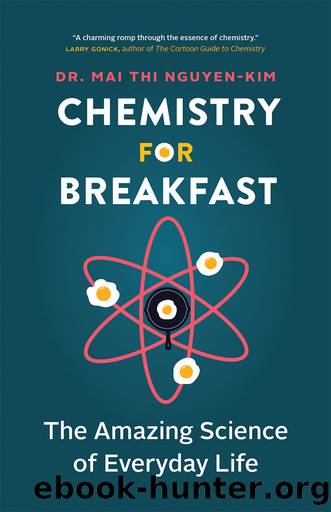Chemistry for Breakfast by Mai Thi Nguyen-Kim

Author:Mai Thi Nguyen-Kim [Nguyen-Kim, Mai Thi]
Language: eng
Format: azw3, epub
Publisher: Greystone Books
Published: 2021-04-12T16:00:00+00:00
Everybody talks about antioxidants; the word even gets bandied about in cosmetics commercials. The chemicalâand literalâdefinition of an antioxidant is a substance that prevents oxidation because it likes to react with oxygen and does this well. A true martyr, an antioxidant throws itself into the firing line and cries, âLeave the polyphenols alone! Take me instead!â
LEMON JUICE IS also acidic. And acid obstructs many enzymes. Enzymes are huge, complex molecules, ingeniously shaped and folded like some sort of funky origami. Their three-dimensional structure is the secret to their precision. They can bring two specific reaction partners together by, for example, putting one in a perfectly pre-folded pocket and holding it there to provide the other with better access. But acid can unfold enzymes, meaning that they lose their three-dimensional structure and their effect as a chemical catalyst. This is why pickled gherkins last so long. The acetic acid preserves them. There are even bacteria that, with acid, help to preserve foods. I need to emphasize here that not all bacteria are bad, and sometimes thereâs a fine line between good and bad. Milk goes sour due to lactic acid, which is produced by bacteria. Lactic acid is specifically used to make yogurt; certain lactic acid bacteria are added to the milk, turning it into acidic yet tasty products that last longer. The same trick is used to make sauerkraut, which is famously long-lasting.
Acetic and lactic acid bacteria arenât the problemâthe problem is the CHEMICAL preservatives!
First, letâs agree to call them âartificial preservativesââpre-servatives created in a lab. Look at the ingredients listed on a pack of food and youâll find artificial preservatives indicated by mysterious âE numbers.â The most important are acids such as sorbic acid and its salts, sorbates. Youâll find them listed under E 200, E 202, and E 203. Their chemical structure is a little like that of fatty acids and their salts, which we use as soaps. They are metabolized like natural fatty acids in foods, and you donât need to worry about toxicity. Sorbates and sorbic acid also have a fairly unobtrusive taste and smell.
Sometimes other acids are needed too, such as benzoic acid and its salts, benzoates. They can be found under numbers E 210 through E 213. They target yeasts and molds that run rampant even at low pH levels (i.e., in the presence of other acids) and are used in acidic foods like mayonnaise, canned fish, pickles, and soft drinks. Benzoic acid isnât as free from scandal as sorbic acid. Thereâs a suspicion that benzoic acid may make children hyperactive, but as the European Food Safety Authority has established, there is no scientific evidence to back this up. Benzoic acid and benzoates are officially classed as safe.
As a chemist, I see some objections that particularly annoy me. Again and again, I read that benzoic acid is a naturally occurring substance and therefore harmless, but benzoates are artificial and therefore dangerous. This is nothing more than mindless chemismâbenzoic acid and benzoates are two different forms of the same molecule! Like fatty acids, benzoic acid is a carboxylic acid.
Download
Chemistry for Breakfast by Mai Thi Nguyen-Kim.epub
This site does not store any files on its server. We only index and link to content provided by other sites. Please contact the content providers to delete copyright contents if any and email us, we'll remove relevant links or contents immediately.
Whiskies Galore by Ian Buxton(40506)
Introduction to Aircraft Design (Cambridge Aerospace Series) by John P. Fielding(32346)
Rewire Your Anxious Brain by Catherine M. Pittman(17599)
Craft Beer for the Homebrewer by Michael Agnew(17462)
Cat's cradle by Kurt Vonnegut(13894)
Sapiens: A Brief History of Humankind by Yuval Noah Harari(13073)
The Tidewater Tales by John Barth(12038)
Leonardo da Vinci by Walter Isaacson(11918)
Underground: A Human History of the Worlds Beneath Our Feet by Will Hunt(11264)
The Radium Girls by Kate Moore(10915)
Thinking, Fast and Slow by Kahneman Daniel(10620)
The Art of Thinking Clearly by Rolf Dobelli(8862)
A Journey Through Charms and Defence Against the Dark Arts (Harry Potter: A Journey Throughâ¦) by Pottermore Publishing(8026)
Mindhunter: Inside the FBI's Elite Serial Crime Unit by John E. Douglas & Mark Olshaker(7848)
Wonder by R. J. Palacio(7078)
Turbulence by E. J. Noyes(7057)
Tools of Titans by Timothy Ferriss(6964)
Change Your Questions, Change Your Life by Marilee Adams(6654)
The Complete Stick Figure Physics Tutorials by Allen Sarah(6646)
